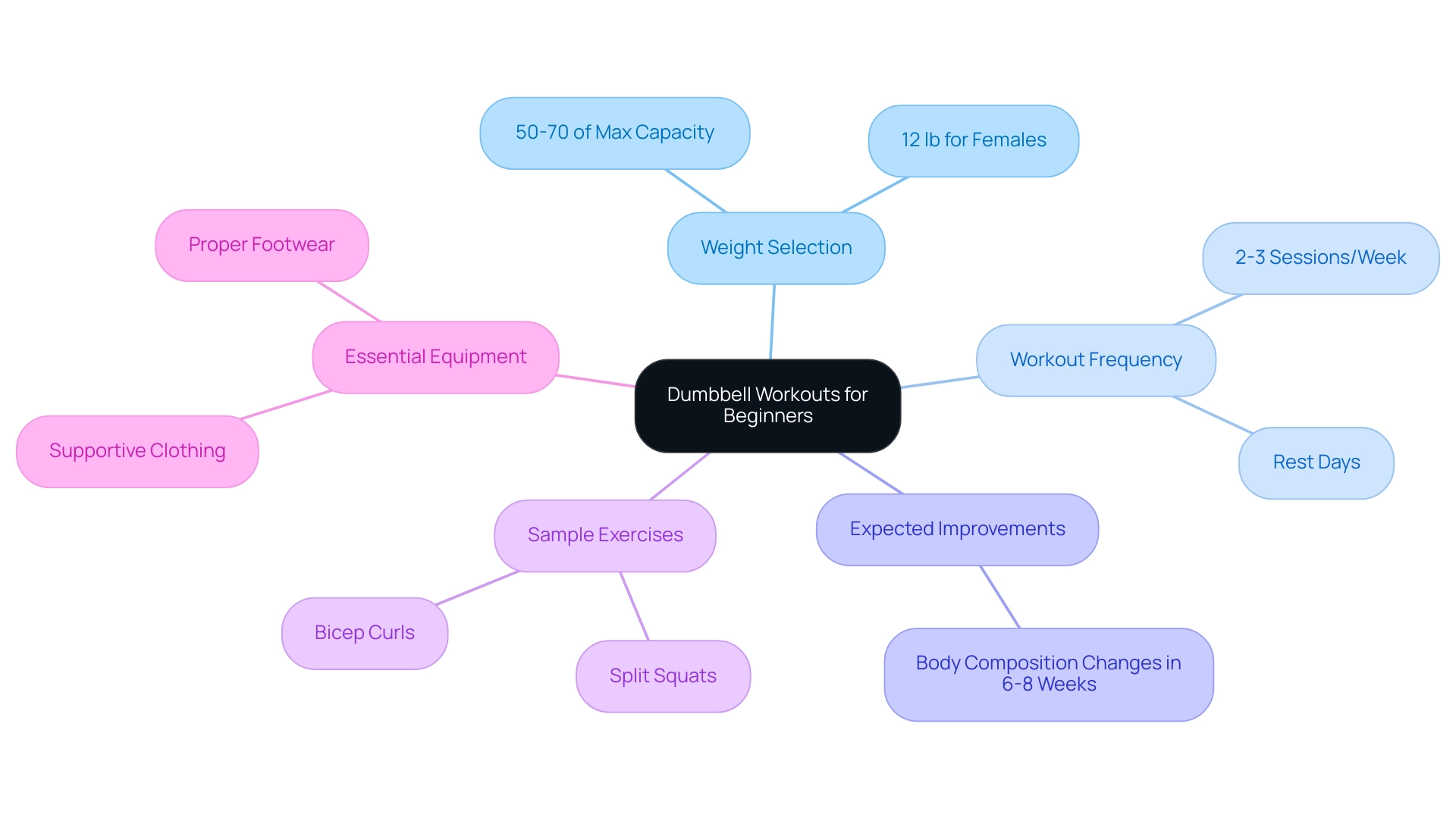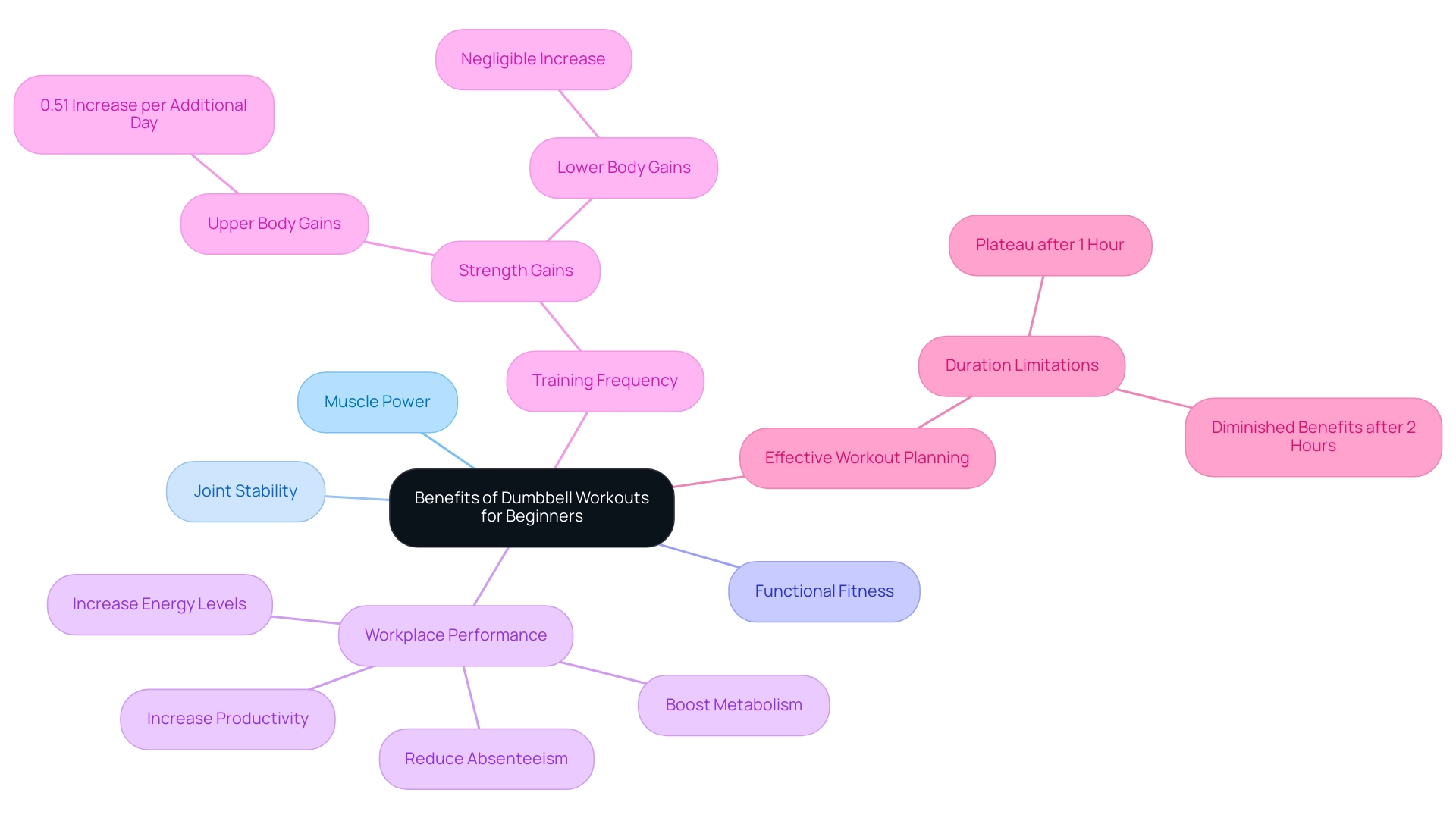Overview
A beginner dumbbell routine is an essential starting point for individuals new to strength training, focusing on fundamental exercises that enhance muscle power and overall fitness. The article emphasizes that these routines not only help beginners learn proper techniques to minimize injury risks but also foster gradual strength development, making them accessible and beneficial for anyone embarking on a fitness journey.
Introduction
Embarking on a strength training journey can be both exciting and daunting, especially for beginners. Dumbbell workouts serve as an ideal entry point, offering a versatile and accessible means to build strength and enhance overall fitness. These routines not only engage multiple muscle groups but also lay the groundwork for proper technique and confidence in lifting.
With a focus on essential exercises and the importance of mastering form, individuals can transform their approach to fitness, ensuring safety while maximizing results. As research highlights the profound benefits of strength training—ranging from improved body composition to increased workplace productivity—it's clear that integrating dumbbell routines into a fitness regimen can lead to lasting health improvements.
This article delves into the fundamentals of beginner dumbbell training, empowering individuals to take charge of their well-being and achieve their fitness goals.
Understanding Beginner Dumbbell Routines
A beginner dumbbell routine serves as a crucial entry point for individuals starting their fitness journey. Dumbbells are not only versatile and user-friendly but also provide an opportunity to engage multiple muscle groups effectively. By concentrating on essential movements, these routines establish the foundation for developing power and improving overall fitness.
For novices, the main objective is to create a solid base in resistance principles by following a beginner dumbbell routine, ensuring they learn proper techniques and gradually build confidence in their lifting skills. Starting with a beginner dumbbell routine that incorporates lighter weights and emphasizes proper form is essential; this approach allows newcomers to adapt to the physical demands of resistance exercise while significantly reducing the risk of injury. Notably, a 2019 review by Lopes et al. determined that resistance exercise with elastic bands can produce power improvements similar to conventional equipment, emphasizing that effective workouts are available for everyone, regardless of previous experience. Additionally, statistics show that the rest-pause group achieved greater gains in hypertrophy in thigh muscles at 11 ± 14% compared to 1 ± 7% for traditional sets. This highlights the effectiveness of varying instructional methods.
Furthermore, a case study by Wirth et al. (2016) involving 83 men practicing twice a week demonstrated effective outcomes in power measurements, reinforcing the benefits of structured beginner routines. With the right mindset and support, starting a weightlifting routine can be a transformative step towards enhanced health and fitness.
s. The central node represents the overall concept, with branches showing key categories related to beginner dumbbell routines.](https://images.tely.ai/telyai/rnkgdmat-the-central-node-represents-the-overall-concept-with-branches-showing-key-categories-related-to-beginner-dumbbell-routines.webp)
Essential Exercises for Beginners: Building Your Dumbbell Routine
For those beginning their strength development journey, a beginner dumbbell routine that incorporates essential weightlifting exercises is crucial for building a solid foundation. Key movements include:
- The dumbbell squat, which effectively strengthens the legs and core
- The dumbbell bench press, focusing on the chest and triceps
- The bent-over row, which should be performed for 10-15 repetitions to target the back muscles
Each exercise promotes balanced development across major muscle groups, enhancing coordination and stability—both vital for progressing in weight training.
As Stephanie Mansour aptly puts it, a beginner dumbbell routine can help you achieve an effective workout whether you’re just starting out, have lofty strength goals, or are in a time crunch. For a beginner dumbbell routine, beginners should aim for 2-3 sets of 8-12 repetitions for each exercise, gradually increasing to five sessions a week when ready. A prime example is the Hammer Curl, where you stand with weights at your sides and lift them towards your shoulders, palms facing in, repeating for 10 times to effectively engage the biceps.
Additionally, incorporating exercises like the Burpee Over 'bells x 10, which involves stepping back into a press-up position, performing a push-up, standing up, and jumping over the dumbbells, can add variety and challenge to your routine. This organized method not only develops power but also prepares the ground for greater accomplishments in fitness.

Frequently Asked Questions About Dumbbell Workouts for Beginners
Determining the appropriate starting weight is a common concern for newcomers embarking on their beginner dumbbell routine. For effective and safe lifting, it is advisable to choose a weight that permits the maintenance of proper form while still offering a challenge, typically ranging from 50-70% of one's maximum lifting capacity. Notably, there have been 1,831,967 dumbbell shoulder press lifts recorded, underscoring the popularity and effectiveness of this exercise.
Female newcomers, for instance, are encouraged to aim for a 12 lb lift, which is impressive compared to the general population. Furthermore, establishing a consistent workout frequency is essential; newcomers should aim for 2-3 sessions per week, interspersed with rest days to facilitate recovery and muscle growth. Recent findings indicate that clients can anticipate noticeable improvements in body composition within just six to eight weeks of dedicated weightlifting.
To enhance their exercise, novices should investigate how to advance in weight selection and think about incorporating a beginner dumbbell routine with cardio for a comprehensive fitness routine. An example superset that beginners might incorporate into their beginner dumbbell routine includes:
- Split squats
- Bicep curls
These should be performed with little to no rest in between, providing practical guidance for their routines. By addressing these common queries, individuals are empowered to make informed choices and remain motivated throughout their journey.
Remember, gathering the right equipment, including supportive clothing and footwear, is essential for enhancing the effectiveness and safety of strength workouts. Equip yourself well, and watch your progress soar!

Mastering Form: Key Techniques for Safe Dumbbell Training
Mastering proper form in weightlifting is not just a guideline; it is essential for preventing injuries and maximizing workout effectiveness. Key techniques include:
- Keeping a neutral spine
- Engaging the core
- Controlling movements throughout the full range of motion
For instance, during a dumbbell squat, it is vital for novices to ensure their knees align over their toes while keeping their back straight.
Practicing these movements in front of a mirror or with a skilled trainer can provide valuable feedback, fostering an environment of safe learning. A case study on knee osteoarthritis in former athletes reveals that individuals with previous knee injuries face a significantly increased risk of developing knee osteoarthritis, with an odds ratio of 4.73. This highlights the severe consequences of neglecting proper form.
Moreover, a serious incident involving a 9-year-old boy who died when a barbell fell on him underscores the potential dangers of improper training practices. By prioritizing proper technique, newcomers can establish a solid foundation for a successful fitness journey by following a beginner dumbbell routine, enabling them to advance confidently into more complex exercises. Remember, as Hamid Mahdavi Mohtasham emphasizes,
Those with a solid foundation in technique are better equipped to handle heavier weights safely, avoiding the injuries that can derail their progress.
Embracing these practices today not only protects your physical health but also empowers your overall fitness journey.

The Benefits of Dumbbell Workouts: Why Beginners Should Start
A beginner dumbbell routine stands out as a highly beneficial option for beginners, offering a multitude of advantages that foster muscle power, enhance joint stability, and improve overall functional fitness—key elements for effectively navigating daily activities. Tailoring dumbbell routines to individual fitness levels and objectives not only makes them versatile but also accessible to everyone. Research indicates that consistent resistance exercise, especially when conducted for a minimum of 30 minutes three times each week, can boost metabolism, improve body composition, and increase energy levels, all of which aid in enhanced workplace performance and motivation.
Notably, studies indicate that employees who engage in regular exercise report feeling more motivated and less fatigued, which can lead to increased productivity and satisfaction at work. Furthermore, participation in exercise programs has been linked to a reduction in absenteeism and presenteeism, highlighting the broader impact of fitness on workplace dynamics. It's important to emphasize that the advantages of resistance exercise plateau after one hour and diminish after two hours, highlighting the significance of effective workout planning.
For those just starting their fitness journey, a beginner dumbbell routine can lead to enduring health improvements and a profound sense of accomplishment. As Nick Rizzo, Fitness Research Director, articulates, 'The best program for beginners is Stronglifts 5x5 Workout,' showcasing a simple yet effective approach. Moreover, current studies reveal that increasing training frequency, particularly for upper body exercises, can yield measurable strength gains, as evidenced by the case study titled 'Frequency and Strength Gain Slopes,' which found that each additional training day for upper body exercises increased weekly strength gains by 0.51%.
This supports the notion that consistent practice is crucial for progress. Therefore, by championing dumbbell workouts, HR Benefits Managers can empower their teams to embrace a healthier lifestyle and achieve their fitness aspirations while enhancing their motivation and emotional well-being at work.

Conclusion
Embarking on a strength training journey with dumbbells is a powerful step towards enhanced fitness and well-being. By starting with foundational exercises, individuals can effectively engage multiple muscle groups, promoting balanced development and improved coordination. Emphasizing proper technique not only safeguards against injuries but also builds confidence, enabling beginners to progress safely and efficiently.
The advantages of incorporating dumbbell workouts are profound. They not only foster muscle strength and joint stability but also contribute to improved functional fitness, which is essential for daily activities. Research indicates that consistent strength training can elevate energy levels and enhance workplace productivity, creating a ripple effect that benefits both personal health and organizational dynamics.
Ultimately, integrating dumbbell routines into a fitness regimen is not just about physical transformation; it’s about cultivating a mindset of empowerment and resilience. By prioritizing strength training, individuals can unlock their potential, achieve their fitness goals, and foster a culture of health and motivation within their teams. Now is the time to embrace the journey, harness the benefits of dumbbell workouts, and inspire a commitment to well-being that extends beyond the gym.




